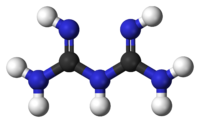- Biguanide
-
Biguanide 
 imidodicarbonimidic diamideOther namesDiguanide, 2-carbamimidoylguanidine
imidodicarbonimidic diamideOther namesDiguanide, 2-carbamimidoylguanidineIdentifiers CAS number 56-03-1 
PubChem 5939 ChemSpider 5726 
KEGG C07672 
ChEBI CHEBI:3095 
Jmol-3D images Image 1
Image 2- C(=N)(N)NC(=N)N
C(=NC(=N)N)(N)N
Properties Molecular formula C2H7N5 Molar mass 101.11 g/mol  (verify) (what is:
(verify) (what is:  /
/ ?)
?)
Except where noted otherwise, data are given for materials in their standard state (at 25 °C, 100 kPa)Infobox references Biguanide can refer to a molecule, or to a class of drugs based upon this molecule. Biguanides can function as oral antihyperglycemic drugs used for diabetes mellitus or prediabetes treatment. They are also used as antimalarial drugs.
The disinfectant polyaminopropyl biguanide (PAPB) features biguanide functional groups.
Contents
Examples
Examples of biguanides:
- Metformin - widely used in treatment of diabetes mellitus type 2
- Phenformin - withdrawn from the market in most countries due to toxic effects
- Buformin - withdrawn from the market due to toxic effects
- Proguanil - an antimalarial drug.
History
Galega officinalis (French lilac) was used for diabetes treatment in traditional medicine for centuries. In the 1920s, guanidine compounds were discovered in Galega extracts. Animal studies showed that these compounds lowered blood glucose levels. Some less toxic derivatives, synthalin A and synthalin B, were used for diabetes treatment, but after the discovery of insulin they were forgotten for the next several decades. Biguanides were reintroduced into Type 2 diabetes treatment in the late 1950s. Initially phenformin was widely used, but its potential for sometimes fatal lactic acidosis resulted in its withdrawal from pharmacotherapy in most pharmacopeias (in the U.S. in 1977). Metformin has a much better safety profile, and it is the principal biguanide drug used in pharmacotherapy worldwide.
Pharmacotherapy
Biguanides do not affect the output of insulin, unlike other hypoglycemic agents such as sulfonylureas and meglitinides. Therefore, not only are they effective in Type 2 diabetics but they can also be effective in Type 1 patients in concert with insulin therapy.
Mechanism of action
The mechanism of action of biguanides is not fully understood. However, in hyperinsulinemia, biguanides can lower fasting levels of insulin in plasma. Their therapeutic uses derive from their tendency to reduce gluconeogenesis in the liver, and, as a result, reduce the level of glucose in the blood. Biguanides also tend to make the cells of the body more willing to absorb glucose already present in the blood stream, and there again reducing the level of glucose in the plasma.
Side effects and toxicity
The most common side effect is diarrhea and dyspepsia, occurring in up to 30% of patients. The most important and serious side effect is lactic acidosis, therefore metformin is contraindicated in renal insufficiency. Renal functions should be assessed before starting metformin. Phenformin and buformin are more prone to cause acidosis than metformin; therefore they have been practically replaced by it. However, when metformin is combined with other drugs (combination therapy), hypoglycemia and other side effects are possible.
References
- Rang et al., Pharmacology, 5th Edition, 2003, p 388
Oral anti-diabetic drugs and Insulin analogs (A10) Insulin BiguanidesK+ ATPMeglitinides/"glinides"GLP-1 analogsfast-acting (Insulin lispro • Insulin aspart • Insulin glulisine) • short-acting (Regular insulin) • long-acting (Insulin glargine • Insulin detemir • NPH insulin) • ultra-long-acting (Insulin degludec†) • inhalable Exubera‡Other Amylin analogSGLT2 inhibitorsOtherBenfluorex‡ • Tolrestat‡Antiparasitics – antiprotozoal agents – Chromalveolate antiparasitics (P01) Alveo-
lateIndividual
agentsOtherSulfadoxine • sulfamethoxypyrazineCoformulationFansidar# (sulfadoxine/pyrimethamine)OtherCombi-
nationsartemether-lumefantrine#
artesunate-amodiaquine (ASAQ)
artesunate-mefloquine (ASMQ)
dihydroartemisinin-piperaquine
artesunate-pyronaridineOther combinations
(not co-formulated)artesunate/SP • artesunate/mefloquine •
quinine/tetracycline • quinine/doxycycline • quinine/clindamycinHetero-
kontCategories:- Guanidines
- Biguanides
- C(=N)(N)NC(=N)N
Wikimedia Foundation. 2010.



